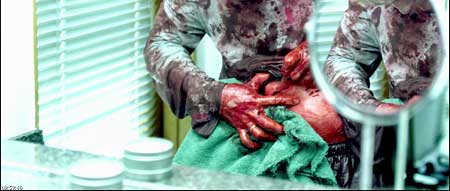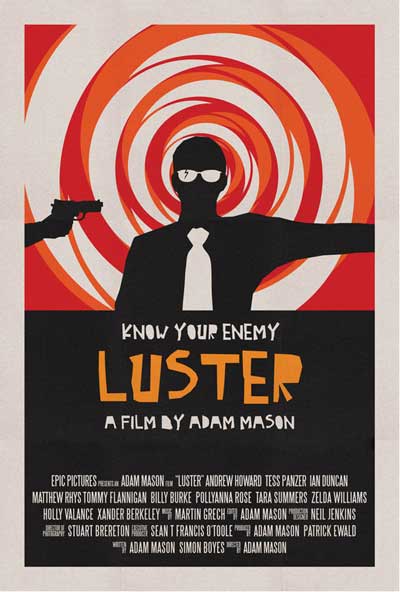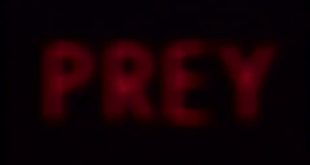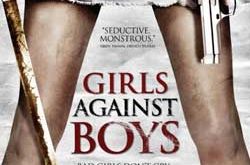Thomas Luster is a troubled businessman who tries to make sense of a life being driven out-of-control by a force closer to home than he first realizes. When he discovers that the man working against him is another side of his own personality he is forced to fight back against his manipulative alter-ego as murder, madness and mayhem combine to take Luster on the most bizarre and terrifying ride of his life.
REVIEW:
“Luster” is another thriller from veteran straight-to-DVD director Adam Mason, and starring frequent collaborator Andrew Howard. Mason (of “Broken” (2006), and “The Devil’s Chair” (2007) fame) gives his fans a fun, if un-original, tale about multiple personalities and the violence that one crazy person can initiate.
After a few days of misplaced belongings, and some strange letters, Thomas Luster (Howard) installs a camera system in his house to catch intruders. This exposition goes by fast, as Mason and his editor understand the tension they’re building, and skip unnecessary filler. Once the situation has been set, the filmmakers give the viewers some taught dialogue scenes between characters.
Immediately the audience will notice some strong performances. It seems to be Mason’s strong point as a director. Howard delivers as the confused protagonist and victim of circumstance, and as Luster, his raging alter-ego. The real stars here though, are the supporting cast. Tom’s wife, played by Tess Panzer, is perfect for the role. She does not overact, or deliver her lines with melodrama. She plays the part very naturally. Tommy Flanagan (“Braveheart” (1995), “Sin City” (2005)) and Billy Burke (“Twilight” (2008), “Red Riding Hood” (2011)) play smaller roles, as two of Tom’s local friends, who fall victim to his alter-ego’s vengeance. Both deliver fun performances and humor to their roles, and are very entertaining.
Interestingly, the only way that Tom and Luster communicate is through phone messages, and the security tapes Tom has placed throughout his house. What is strange though, is the self-help tapes that serve as narration throughout the film. The advice they give, conveniently fits any situation given in the film, and just sound strange to begin with. Risks should be taken with low-budget thrillers such as this. Sometimes they can pay off and change the game. Sometimes those risks fall flat. Unfortunately, the strange narration in this film is simply a risk that did not pay off.
After a relatively slow second act, though this writer did not view that as negative, Mason jars his audience back to the edge of their seats with an extremely gory bathroom sequence involving a condom, a key, and some hypodermic needles. This short segment gives insight into both Tom’s and Luster’s personalities, and cements the second half of the film.
In a very unique twist on the genre, the separate personalities call a truce in the third act. Most films like this have a fight to the bitter end, but this simple “twist” gives horror fans an unexpected third act. That alone can make this viewing worthwhile.
The cinematography, while simple in construction is above average for shot-on-video independent horror films. Cinematographer, Stuart Brereton, fails to hide his television roots, but still delivers well choreographed, motivated camera moves throughout, with simple but effective compositions.
The climax of the film, does eventually become predictable, and falls to cliché. This writer wishes the truce would have become a major plot point, instead of a red herring. The places the story could have gone would have been very unique. Instead, the evil side of Luster, blackmails Tom into helping him destroy evidence of murders, or even continue his bloody adventures. The completion of the story seems positive for our protagonist, and gives the audience a false sense of security, until the final confrontation between the two sides of Thomas Luster. The final two minutes or so, while a bit anti-climactic, are also unexpected, which is something most fans of this genre appreciate.
By the end of the film, it is apparent why this is one of Mason’s least known works. He has gotten much attention as a modern horror filmmaker, but “Luster” falls flat. A lot is done that shows potential from those involved in making the film, and it won’t upset most ardent fans of the filmmaker, but it won’t welcome many new viewers to become fans.
Luster (2010)
 Horror News | HNN Official Site | Horror Movies,Trailers, Reviews
Horror News | HNN Official Site | Horror Movies,Trailers, Reviews










The version of this film that I saw at The Boston Underground Film Festival was great. However, I saw the completed version yesterday and it is terrible. It’s because of one thing; that TERRIBLE and annoying radio announcer voice between every. freakin’. scene. It sounds like a small thing but it took so much away from the film. That last scene; slow zoom towards Tom doing (don’t want to give it away) and then he looks right at the camera and smiles. Perfect. Now there is this annoying announcer voice right up until the end. It really ruined the entire film for me. Adam Mason, why did you destroy your own film?
i totally agree. that announcer VO is incredibly distracting.